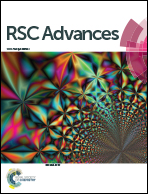Effective incorporation of rhBMP-2 on implantable titanium disks with microstructures by using electrostatic spraying deposition†
Abstract
Incorporation of bioactive molecules, such as bone morphogenetic proteins (rhBMP-2) is an effective way to improve the surface bioactivity and then enhance the osseointegration of the metallic implants. However, preserving/enhancing the osteogenic capacity of rhBMP-2 is still one of the greatest challenges. In this study, electrostatic spraying deposition was applied to construct a biodegradable chitosan coating loaded with rhBMP-2 on hydrophilic SLA-treated titanium disks. A series of analytical tools including scanning electron microscopy, atomic force microscopy, and contact angle measurements were used to characterize the physical/chemical properties of the coatings. The release behaviour of model proteins were compared and regulated for different surfaces. Biological evaluation in terms of cell adhesion, proliferation, and differentiation was done to study the effects of the coating materials/structure on the osteoblast response. In vitro experiments demonstrated the controlled release of proteins from the ES-P-SLA disks and showed that the released rate/concentration could be regulated by the loading amount and the spraying time. Microscopic visualization of the myblast morphology on the ES-P-SLA disks exhibited enhanced cellular adhesion at the initial incubation. MTT testing and ALP activity results confirmed the enhanced proliferation and differentiation of rhBMP-2 over a two-week period. Therefore, we believe the combination of coating properties/rhBMP-2 bioactivity with the surface topography will speed up bone-formation and improve the implant osseointegration. The key technologies developed in this study could be applied for other biomolecules, undoubtedly benefiting the healthcare sector and quality of life.


 Please wait while we load your content...
Please wait while we load your content...